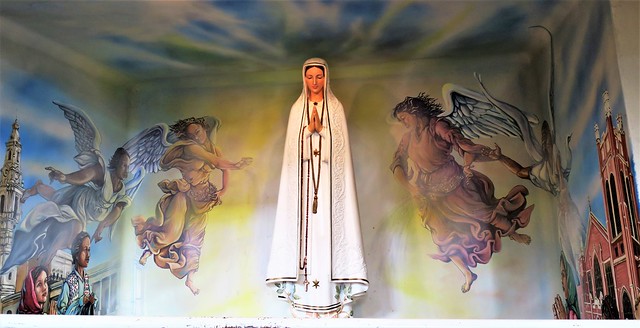 |
| Segundo Barrio, El Paso, Texas. |
El Paso's Segundo Barrio (Second Ward) isn't just about artistic murals, such as here and here.
There is a living community here, a historic one. Earlier, I posted about a walk through Segundo Barrio, an encounter with a sensory garden.
The PBS station in Austin, KLRU, has a series called One Square Mile, in which it zeroes in on one square mile of a community, and tell stories about it. One episode is about El Paso's Segundo Barrio.
You can watch it in its entirety here. It's only half an hour long.
Sacred Heart is one of Segundo Barrio's cultural anchors. I attended Mass here one Sunday.
 |
| Sacred Heart Church, Segundo Barrio, El Paso, Texas. |
Below is a slide show of Segundo Barrio, which includes my Sacred Heart photos:
"My mom and my dad we always had in the glove compartment a salt shaker." So reminisced (in the documentary) a Border Patrol officer born in Juarez, but who grew up in Segundo Barrio. (His family and I - we are from the same tribe.)
He alludes to Segundo Barrio as "a way to connect, it's an opportunity, an opening, a gateway, to both countries."
From a 2013 article in Texas Monthly, The Other Ellis Island:
Segundo Barrio, with its turn-of-the-century tenement buildings and dozens of brightly colored murals, is one of the most historic neighborhoods in the country. As the first community that immigrants encounter after crossing the Rio Grande from Juárez, it is known as the Ellis Island of the border, and over the years it has played a role in the Mexican Revolution, the zoot-suit pachuco counterculture, and the Chicano civil rights movement. A mural celebrating this history ... depicts well-known residents of the barrio past and present and, instead of the Statue of Liberty, shows the Virgin Mary welcoming newcomers from across the river with a flashlight and a towel.
 |
| Virgin Mary welcoming immigrants, Segundo Barrio, El Paso, Texas. |
A young teacher in a Segundo Barrio school: "We have students who have never been to the inside of El Paso, who have never gone to the west side, and so sometimes that's part of my job when we take [my robotics students] to competitions, to [show them] there's more than downtown El Paso. Go and see what's out there and see how their lives are different than ours."
There are, as one Segundo Barrio resident explains in the documentary, families who've lived in Segundo Barrio for three and four generations.
A muralist in the documentary explains the cultural importance of the murals - they preserve the memories of the neighborhood's cultural experience. They remind the neighborhood residents of their shared history. A sort of family album where the pictures are on walls instead of inside a bound book. He further suggests that "We, in a way, created El Paso" by dint of the Segundo Barrio's residents who went into the larger reaches of the city to clean the houses of those more wealthy, those who went out to work in the fields that produced the food for El Paso, and those who went out to work in homes to repair and maintain and build structures.
El Paso's rebirthing of a trolley system will go through Segundo Barrio. The tracks have been laid. Streets previously in casual disrepair are now new and white. How will this affect the community, I wonder. Build it, deepen its richness of community? Or begin a process of gentrification, in which the neighborhood suddenly catches the eyes of speculators who hearken back to conquistadores of old in search for those streets paved of gold? Or somewhere in between, a place that honors the families and neighbors who've been in Segundo Barrio all along and which invests wealth and opportunities?

No comments:
Post a Comment